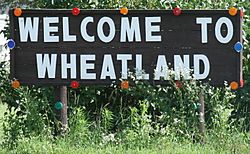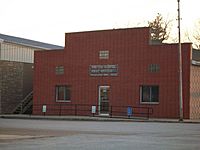Wheatland, Iowa facts for kids
Quick facts for kids
Wheatland, Iowa
|
|
|---|---|
 |
|

Location of Wheatland, Iowa
|
|
| Country | |
| State | |
| County | Clinton |
| Area | |
| • Total | 0.57 sq mi (1.49 km2) |
| • Land | 0.57 sq mi (1.49 km2) |
| • Water | 0.00 sq mi (0.00 km2) |
| Elevation | 689 ft (210 m) |
| Population
(2020)
|
|
| • Total | 775 |
| • Density | 1,350.17/sq mi (521.63/km2) |
| Time zone | UTC-6 (Central (CST)) |
| • Summer (DST) | UTC-5 (CDT) |
| ZIP code |
52777
|
| Area code(s) | 563 |
| FIPS code | 19-84945 |
| Website | www.cityofwheatland.org |
Wheatland is a city in Clinton County, Iowa, United States. The population was 775 at the time of the 2020 census.
History
Wheatland was platted in 1858 under the leadership of John Bennett. The town was named for President James Buchanan's estate Wheatland in Lancaster, Pennsylvania. The entire township (Spring Rock) had a white population of only 101 in 1850, but that number rose to 756 in 1860. A significant body of early settlers all came from the village of Wunderthausen in central Germany. The Germans founded the first church in town in 1857 with a Presbyterian affiliation. This relationship was dissolved in 1861 with the incorporation of St. Paul's German Reformed Church (now St. Paul's United Church of Christ). The First Presbyterian Church was organized in 1858, though no longer functions. Wheatland was legally incorporated on July 13, 1869.
Geography
Wheatland is located at 41°49′58″N 90°50′22″W / 41.83278°N 90.83944°W (41.832891, -90.839490).
According to the United States Census Bureau, the city has a total area of 0.61 square miles (1.58 km2), all land.
Demographics
| Historical population | |||
|---|---|---|---|
| Census | Pop. | %± | |
| 1870 | 788 | — | |
| 1880 | 616 | −21.8% | |
| 1890 | 569 | −7.6% | |
| 1900 | 475 | −16.5% | |
| 1910 | 539 | 13.5% | |
| 1920 | 549 | 1.9% | |
| 1930 | 539 | −1.8% | |
| 1940 | 535 | −0.7% | |
| 1950 | 568 | 6.2% | |
| 1960 | 643 | 13.2% | |
| 1970 | 832 | 29.4% | |
| 1980 | 840 | 1.0% | |
| 1990 | 723 | −13.9% | |
| 2000 | 772 | 6.8% | |
| 2010 | 764 | −1.0% | |
| 2020 | 775 | 1.4% | |
| U.S. Decennial Census | |||
2020 census
As of the census of 2020, there were 775 people, 317 households, and 184 families residing in the city. The population density was 1,351.0 inhabitants per square mile (521.6/km2). There were 339 housing units at an average density of 591.0 per square mile (228.2/km2). The racial makeup of the city was 95.7% White, 0.0% Black or African American, 0.3% Native American, 0.1% Asian, 0.0% Pacific Islander, 0.6% from other races and 3.2% from two or more races. Hispanic or Latino persons of any race comprised 1.3% of the population.
Of the 317 households, 32.8% of which had children under the age of 18 living with them, 38.8% were married couples living together, 11.0% were cohabitating couples, 27.4% had a female householder with no spouse or partner present and 22.7% had a male householder with no spouse or partner present. 42.0% of all households were non-families. 34.4% of all households were made up of individuals, 19.2% had someone living alone who was 65 years old or older.
The median age in the city was 35.9 years. 28.8% of the residents were under the age of 20; 5.3% were between the ages of 20 and 24; 25.5% were from 25 and 44; 19.4% were from 45 and 64; and 21.0% were 65 years of age or older. The gender makeup of the city was 47.4% male and 52.6% female.
2010 census
As of the census of 2010, there were 764 people, 294 households, and 197 families living in the city. The population density was 1,252.5 inhabitants per square mile (483.6/km2). There were 317 housing units at an average density of 519.7 per square mile (200.7/km2). The racial makeup of the city was 98.7% White, 0.3% African American, 0.7% Native American, 0.1% Asian, and 0.3% from two or more races. Hispanic or Latino of any race were 1.7% of the population.
There were 294 households, of which 34.7% had children under the age of 18 living with them, 48.0% were married couples living together, 12.2% had a female householder with no husband present, 6.8% had a male householder with no wife present, and 33.0% were non-families. 27.9% of all households were made up of individuals, and 14% had someone living alone who was 65 years of age or older. The average household size was 2.47 and the average family size was 2.98.
The median age in the city was 40.6 years. 26.8% of residents were under the age of 18; 6.2% were between the ages of 18 and 24; 23.4% were from 25 to 44; 23.6% were from 45 to 64; and 20% were 65 years of age or older. The gender makeup of the city was 46.9% male and 53.1% female.
Education
The Calamus–Wheatland Community School District operates public schools serving the community. The district was established on July 1, 1985, by the merger of the Calamus and Wheatland school districts. Calamus–Wheatland High School in Wheatland is a comprehensive four year high school.
Notable person
- Elmer George Homrighausen (1900–1982), Dean of Princeton Theological Seminary from 1954 to 1970.
See also
 In Spanish: Wheatland (Iowa) para niños
In Spanish: Wheatland (Iowa) para niños


